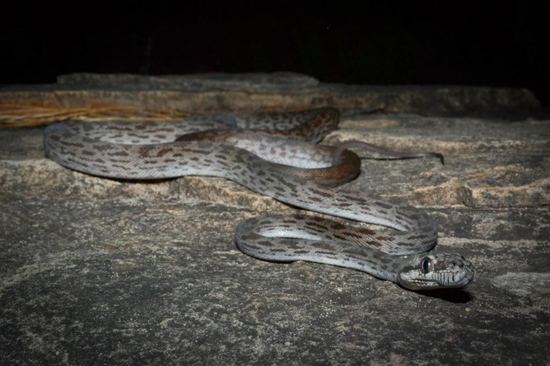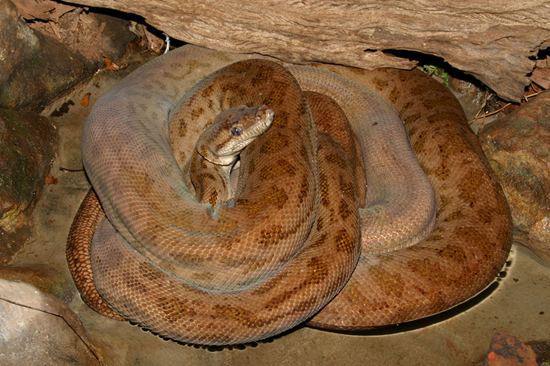Subphylum Vertebrata Suborder Serpentes Scientific name Morelia oenpelliensis Rank Species | Phylum Chordata Genus Morelia Higher classification Morelia | |
 | ||
Similar | ||
Oenpelli python safari 7 30 report
The Oenpelli python, known in binomial nomenclature as Morelia oenpelliensis or Simalia oenpelliensis, is a large python species endemic to the sandstone massif area of the western Arnhem Land region in the Northern Territory of Australia. No subspecies are recognised. Like all pythons, it is a non-venomous constrictor. It has been called the rarest python in the world. Two notable characteristics of the species are the unusually large size of its eggs and its ability to change colour.
Contents
- Oenpelli python safari 7 30 report
- Description
- Behaviour
- Geographic range
- Habitat
- Conservation status
- Taxonomy
- Etymology
- References

Description

A large and rare species of Morelia (or Simalia), a genus of the family Pythonidae, adults grow to more than 4 m (13 ft) in length, and one specimen in captivity is reportedly more than 5 m (16 ft) long. They are unusually thin in proportion to their length, relative to other pythons.
The colour pattern is dark olive-brown with darkened blotches. The belly is pale and dull, varying from cream to yellow.

Oenpelli pythons are able to change their skin colouration, which tends to be lighter at night and darker in the daytime.

The eggs of the Oenpelli python have been described as "huge". At 110.5 by 60 mm (4.35 by 2.36 in), they are almost twice the size of those for the related amethystine python (Morelia amethystina), which are reported as 70–98 by 45–56 mm (2.8–3.9 by 1.8–2.2 in).
Behaviour
The Oenpelli python is nocturnal and inhabits rock crevices, trees, and caves.
They feed on birds in fruiting trees, and have been speculated to specialise in eating birds. Adults prey on medium-to-large mammals, such as possum or large macropods. Captive specimens eat birds and rodents.
It is an ambush predator that remains motionless for long periods.
Geographic range
The species occurs in a restricted range in the Northern Territory, in the sandstone outcrops of western Arnhem Land.
Habitat
The species is found in habitat located on a sandstone massif, in the regions surrounding the upper reaches of the Cadell, South Alligator and East Alligator rivers. They are territorial animals who roam between discrete positions, such as overhangs and caves in sandstone gorges or in a shady tree. Sightings are also reported in the region's woodland, heathland, and open rocky plains. It is noted as having an association with the Kombalgie sandstone gorges. It is said to be associated with sandstone rock outcrops with dense vegetation.
Conservation status
The total population is poorly surveyed, and no study has been made of the rate of its decline. This is partly due to the inaccessibility of the region, a factor that may help the preservation of the species. The conservation status of Morelia oenpelliensis is listed by the Northern Territory Government as vulnerable to extinction. This has been evaluated by known threatening factors, such as altered land use and fire regimes, and population inferred from the relative abundance of its prey. This is estimated to be below 10,000, which is inferred from several factors. As a large predator, the species is particularly vulnerable to declines in available prey. These larger mammals are more susceptible to changes in land use and threats such as introduced species. Suitable habitat is also limited in the distribution range of the species. The species is known to be illegally collected for private use, which is likely to impact on some subpopulations. This threat is limited by the inaccessibility of its habitat, the same factor that has restricted study of the species. Variation and decline in subpopulations has not been fully evaluated. It is found within a conservation reserve known as Kakadu National Park.
An attempt to start a breeding program was begun in 2012 and has had some limited success. As of July, 2014, the program included six specimens. In early 2015, the first two captive-bred neonates were born.
Taxonomy
Morelia oenpelliensis was first described in 1977 by G. F. Gow, who placed it in the genus Python. It was then categorised by Cogger and Cameron as a species of Morelia. In 2014, a work by Reynolds, Niemiller, and Revell proposed to classify it as Simalia.
Etymology
The specific name, oenpelliensis, is derived from the type locality, which is given as "6.5 km S.W. of Oenpelli, Northern Territory, Australia (12°21'S, 133°01'E)".
